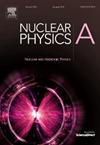利用STAR实验对高能核碰撞中的原子核结构进行成像
IF 2.5
4区 物理与天体物理
Q2 PHYSICS, NUCLEAR
引用次数: 0
摘要
在相对论重离子碰撞中,夸克-胶子等离子体(QGP)性质的提取受到对其初始条件的有限理解的阻碍,其中碰撞离子的核结构起着重要作用。在本论文中,我们首次使用“集体流辅助核形状成像”方法,利用相对论重离子对撞机(RHIC)的数据提取238U的四极变形和三轴性。我们通过比较高度变形的238U和接近球形的197Au碰撞中的大块观测值来实现这一点。在96Ru+96Ru和96Zr+96Zr的碰撞中进行了类似的比较测量,表明96Ru存在中度的四极变形,96Zr存在较大的八极变形,并且这两种物质之间存在明显的中子皮肤差异。展望了这种核形状成像方法作为核结构研究新工具的前景。本文章由计算机程序翻译,如有差异,请以英文原文为准。
Imaging the structure of atomic nuclei in high-energy nuclear collisions from STAR experiment
In relativistic heavy-ion collisions, the extractions of properties of quark-gluon plasma (QGP) are hindered by a limited understanding of its initial conditions, where the nuclear structure of the colliding ions plays a significant role. In these proceedings, we present the first quantitative demonstration using “collective flow assisted nuclear shape imaging” method to extract the quadrupole deformation and triaxiality from 238U using data from the Relativistic Heavy Ion Collider (RHIC). We achieve this by comparing bulk observables in collisions of highly deformed 238U and nearly spherical 197Au. A similar comparative measurement performed in collisions of 96Ru+96Ru and 96Zr+96Zr, suggests the presence of moderate quadrupole deformation of 96Ru, large octupole deformation of 96Zr, as well as an apparent neutron skin difference between these two species. The prospect of this nuclear shape imaging method as a novel tool for the study of nuclear structure is also elaborated.
求助全文
通过发布文献求助,成功后即可免费获取论文全文。
去求助
来源期刊

Nuclear Physics A
物理-物理:核物理
CiteScore
3.60
自引率
7.10%
发文量
113
审稿时长
61 days
期刊介绍:
Nuclear Physics A focuses on the domain of nuclear and hadronic physics and includes the following subsections: Nuclear Structure and Dynamics; Intermediate and High Energy Heavy Ion Physics; Hadronic Physics; Electromagnetic and Weak Interactions; Nuclear Astrophysics. The emphasis is on original research papers. A number of carefully selected and reviewed conference proceedings are published as an integral part of the journal.
 求助内容:
求助内容: 应助结果提醒方式:
应助结果提醒方式:


